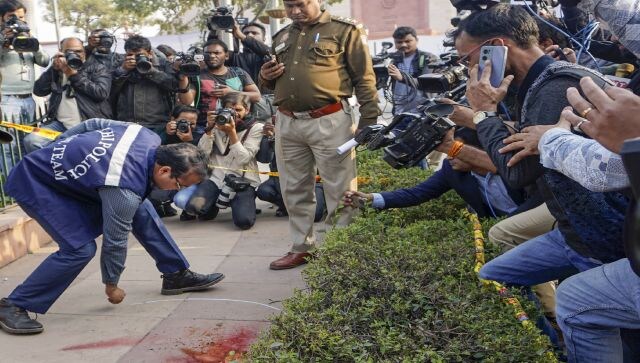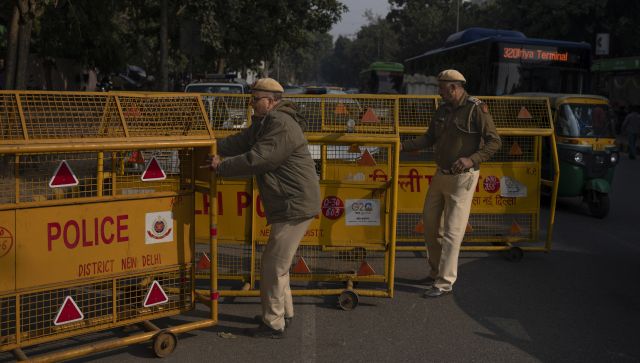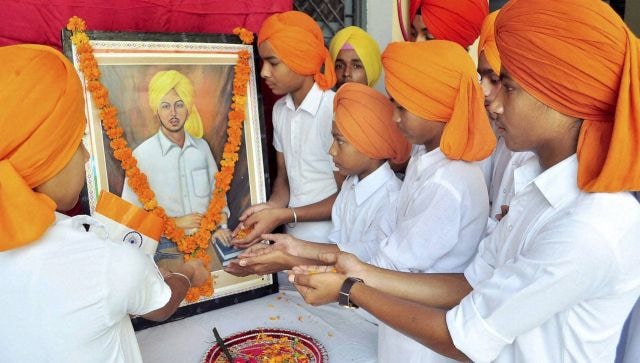It was one of the biggest shockers of the year. On Wednesday, the Parliament saw a massive security breach. Two intruders entered the Lok Sabha and burst yellow smoke canisters and two others burst red and yellow canisters outside the building. In all, six people were involved, of which, five have been arrested. And they had a common connection: Bhagat Singh. The accused have been identified as Sagar Sharma and Manoranjan D , who were held inside the Lok Sabha. Two others, Neelam Devi and Amol Shinde, were arrested outside the Parliament building for sloganeering and spraying the yellow and red powders. Lalit Jha and Vicky Sharma, both from Gurugrum, are the other accused. Jha shot videos of the incident, fled with their cellphones, and is reportedly on the run. Vicky Sharma allegedly sheltered the accused and has been held along with his wife. Also read: Why did the intruders breach Parliament? Was it to protest against unemployment? The six who planned the breach had a lot in common and were staying in a house in Gurugram. Some of them were unemployed and an investigation revealed that they were also inspired by freedom fighter Bhagat Singh. So were the Parliament intruders trying to emulate the revolutionary? We take a look at the daring act from 8 April 1929, when Singh and Batukeshwar Dutt threw bombs at Delhi’s Central Assembly – one of the most heroic moments of India’s Independence movement.
The Bhagat Singh connection Reports say that at least four of the six accused got in touch with each other through social media. A mutual admiration for Bhagat Singh is what connected them. “All four seem to be part of a group called Bhagat Singh fan club. They were inspired by his ideology,” a police official told CNN-News18. D Manoranjan, who masterminded the security breach, is an engineer from Mysuru. While Sagar Sharma is a graduate, who hails from Lucknow, Neelam is a civil service aspirant from Hisar. Anmol Shinde is reportedly an unsuccessful police entrance and military service exam candidate. Also read: Recce of Parliament, 11 months of planning: How 6 accused executed security breach
During interrogation, the four said that they planned the breach to “protest against unemployment and compel policymakers to acknowledge their concerns”, according to a report in ThePrint. The accused claimed that they met on Facebook and were part of other protests including a demonstration in Mohali to rename the airport as Shaheed Bhagat Singh Airport. According to Neelam’s family, the ideology of BR Ambedkar and Bhagat Singh inspired her. She would distribute books on the revolutionary hero to youngsters in her village, neighbours told the local media. [caption id=“attachment_13503002” align=“alignnone” width=“640”] Police personnel investigate after two people jumped into the Lok Sabha chamber from the public gallery, and another two sprayed coloured gas from canisters while protesting outside the Parliament premises, in New Delhi, on 13 December. PTI[/caption] The conspirators reportedly
planned the security breach
for 11 months and even carried out a recce of the Parliament complex during the Monsoon session. Manoranjan and Sagar Sharma have been trying to obtain a Parliament visitor’s pass for the past three months, as per details shared by
BJP MP Pratap Simha’s office
with the police. The two were given passes by Simha. The duo intruded the Parliament,
jumped into the Lok Sabha chamber
and then burst yellow canisters. Eyewitnesses, including BSP MP Shyaam Narayan Yadav, suggested that they jumped off the visitor gallery and rushed towards the speaker’s chair. The choice of yellow also has a connection with Bhagat Singh: It is believed to be the freedom fighter’s favourite colour and has long been associated with him. He too had famously dropped a bomb in Parliament during India’s freedom struggle. [caption id=“attachment_13503062” align=“alignnone” width=“640”]
Police personnel investigate after two people jumped into the Lok Sabha chamber from the public gallery, and another two sprayed coloured gas from canisters while protesting outside the Parliament premises, in New Delhi, on 13 December. PTI[/caption] The conspirators reportedly
planned the security breach
for 11 months and even carried out a recce of the Parliament complex during the Monsoon session. Manoranjan and Sagar Sharma have been trying to obtain a Parliament visitor’s pass for the past three months, as per details shared by
BJP MP Pratap Simha’s office
with the police. The two were given passes by Simha. The duo intruded the Parliament,
jumped into the Lok Sabha chamber
and then burst yellow canisters. Eyewitnesses, including BSP MP Shyaam Narayan Yadav, suggested that they jumped off the visitor gallery and rushed towards the speaker’s chair. The choice of yellow also has a connection with Bhagat Singh: It is believed to be the freedom fighter’s favourite colour and has long been associated with him. He too had famously dropped a bomb in Parliament during India’s freedom struggle. [caption id=“attachment_13503062” align=“alignnone” width=“640”] Delhi police personnel set up a barricade outside the Parliament in New Delhi, after the security breach. AP[/caption] A look back at history Bhagat Singh was inspired by Mahatma Gandhi but after the Non-Coopreation Movement was called off, it made him question the path of non-violence. In college, he met Chandrashekhar Azad, Ram Prasad Bismil, Sukhdev Thapar and other revolutionaries and they formed the Hindustan Socialist Republican Army (HSRA). It appears like the four accused, who breached security in Lok Sabha on Wednesday, were trying to emulate what Bhagat Singh did on 8 April 1929. More than 94 years ago, the freedom fighter and his comrade Batukeshwar Dutt intruded into the chamber of Delhi’s Central Assembly, referred to officially as the Indian Parliament, sending shockwaves across the British Empire. They hurled feeble bombs at the chamber, threw revolutionary pamphlets and raised patriotic slogans. It was a different time then. India was fighting colonial rule and the act went down in history as one of the most heroic moments of the freedom struggle. When the two freedom fighters the Parliament in 1928, their aim was not to hurt anyone. Bhagat Singh wanted the deaf – the British – to listen to him. Indians sat in the legislature but had no power. The HRSA, which was headed by Chandrashekar Azad, wanted to send out a message that the Indian Parliament of the time was pretence. [caption id=“attachment_13503082” align=“alignnone” width=“640”]
Delhi police personnel set up a barricade outside the Parliament in New Delhi, after the security breach. AP[/caption] A look back at history Bhagat Singh was inspired by Mahatma Gandhi but after the Non-Coopreation Movement was called off, it made him question the path of non-violence. In college, he met Chandrashekhar Azad, Ram Prasad Bismil, Sukhdev Thapar and other revolutionaries and they formed the Hindustan Socialist Republican Army (HSRA). It appears like the four accused, who breached security in Lok Sabha on Wednesday, were trying to emulate what Bhagat Singh did on 8 April 1929. More than 94 years ago, the freedom fighter and his comrade Batukeshwar Dutt intruded into the chamber of Delhi’s Central Assembly, referred to officially as the Indian Parliament, sending shockwaves across the British Empire. They hurled feeble bombs at the chamber, threw revolutionary pamphlets and raised patriotic slogans. It was a different time then. India was fighting colonial rule and the act went down in history as one of the most heroic moments of the freedom struggle. When the two freedom fighters the Parliament in 1928, their aim was not to hurt anyone. Bhagat Singh wanted the deaf – the British – to listen to him. Indians sat in the legislature but had no power. The HRSA, which was headed by Chandrashekar Azad, wanted to send out a message that the Indian Parliament of the time was pretence. [caption id=“attachment_13503082” align=“alignnone” width=“640”] School students pay tribute to Bhagat Singh on his birth anniversary at a school in Patiala. The group that breached security were reportedly part of a Bhagat Singh fan club. File photo/PTI[/caption] On 8 April 1929, Lord Irwin, the viceroy, was set to announce the enactment of the Public Safety and Trade Disputes Bills, even after a majority of members in the Assembly had opposed them. The attack was planned for the day. According to the police report, Bhagat Singh and Dutt had carried out a “preliminary reconnaissance” two days ago, reports The Indian Express. The duo sat in the visitor’s gallery dressed in khaki shirts and shorts. They lobbed two bombs after which Bhagat Singh fired two unaimed shots from the pistol. Dutt threw the HRSA pamphlets in the air and they both shouted “Inquilab Zindabad” and “Down with British Imperialism”. “It takes a loud voice to make the deaf hear, with these immortal words uttered on a similar occasion by Valiant, a French anarchist martyr, do we strongly justify this action of ours,” the pamphlets read, according to The Indian Express report. The two did not make any attempts to escape and were arrested. A month after the incident, a trial began. On 12 June 1929, they were sentenced to life in prison. They had no regrets. “Force when aggressively applied is ‘violence’ and is, therefore, morally unjustifiable, but when it is used in the furtherance of a legitimate cause, it has its moral justification,” Bhagat Singh and Dutt said, defending their actions, adding that they were neither “perpetrators of dastardly outrages” nor “lunatics”. Bhagat Singh was later sentenced to death for the murder of British police officer John Saunders, in Lahore in 1928. He was hanged on 23 March 1931 in Lahore Central Jail. With inputs from agencies
School students pay tribute to Bhagat Singh on his birth anniversary at a school in Patiala. The group that breached security were reportedly part of a Bhagat Singh fan club. File photo/PTI[/caption] On 8 April 1929, Lord Irwin, the viceroy, was set to announce the enactment of the Public Safety and Trade Disputes Bills, even after a majority of members in the Assembly had opposed them. The attack was planned for the day. According to the police report, Bhagat Singh and Dutt had carried out a “preliminary reconnaissance” two days ago, reports The Indian Express. The duo sat in the visitor’s gallery dressed in khaki shirts and shorts. They lobbed two bombs after which Bhagat Singh fired two unaimed shots from the pistol. Dutt threw the HRSA pamphlets in the air and they both shouted “Inquilab Zindabad” and “Down with British Imperialism”. “It takes a loud voice to make the deaf hear, with these immortal words uttered on a similar occasion by Valiant, a French anarchist martyr, do we strongly justify this action of ours,” the pamphlets read, according to The Indian Express report. The two did not make any attempts to escape and were arrested. A month after the incident, a trial began. On 12 June 1929, they were sentenced to life in prison. They had no regrets. “Force when aggressively applied is ‘violence’ and is, therefore, morally unjustifiable, but when it is used in the furtherance of a legitimate cause, it has its moral justification,” Bhagat Singh and Dutt said, defending their actions, adding that they were neither “perpetrators of dastardly outrages” nor “lunatics”. Bhagat Singh was later sentenced to death for the murder of British police officer John Saunders, in Lahore in 1928. He was hanged on 23 March 1931 in Lahore Central Jail. With inputs from agencies
)